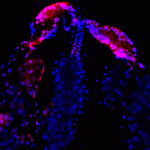Lien vers Pubmed [PMID] – 36288328
Lien DOI – 10.1371/journal.pbio.3001864
PLoS Biol 2022 10; 20(10): e3001864
The explosive emergence of Zika virus (ZIKV) across the Pacific and Americas since 2007 was associated with hundreds of thousands of human cases and severe outcomes, including congenital microcephaly caused by ZIKV infection during pregnancy. Although ZIKV was first isolated in Uganda, Africa has so far been exempt from large-scale ZIKV epidemics, despite widespread susceptibility among African human populations. A possible explanation for this pattern is natural variation among populations of the primary vector of ZIKV, the mosquito Aedes aegypti. Globally invasive populations of Ae. aegypti outside of Africa are considered effective ZIKV vectors because they are human specialists with high intrinsic ZIKV susceptibility, whereas African populations of Ae. aegypti across the species’ native range are predominantly generalists with low intrinsic ZIKV susceptibility, making them less likely to spread viruses in the human population. We test this idea by studying a notable exception to the patterns observed across most of Africa: Cape Verde experienced a large ZIKV outbreak in 2015 to 2016. We find that local Ae. aegypti in Cape Verde have substantial human-specialist ancestry, show a robust behavioral preference for human hosts, and exhibit increased susceptibility to ZIKV infection, consistent with a key role for variation among mosquito populations in ZIKV epidemiology. These findings suggest that similar human-specialist populations of Ae. aegypti in the nearby Sahel region of West Africa, which may be expanding in response to rapid urbanization, could serve as effective vectors for ZIKV in the future.


